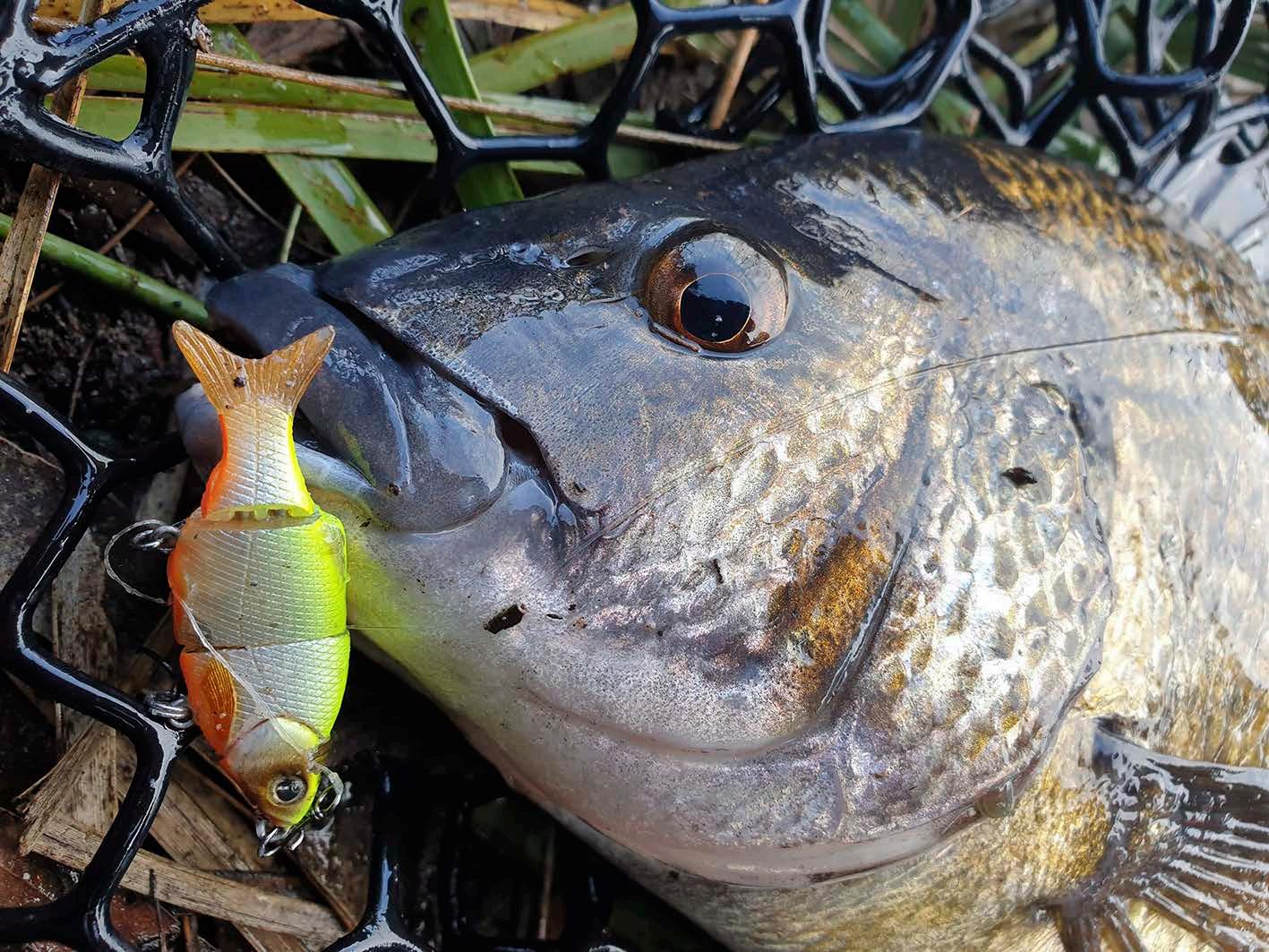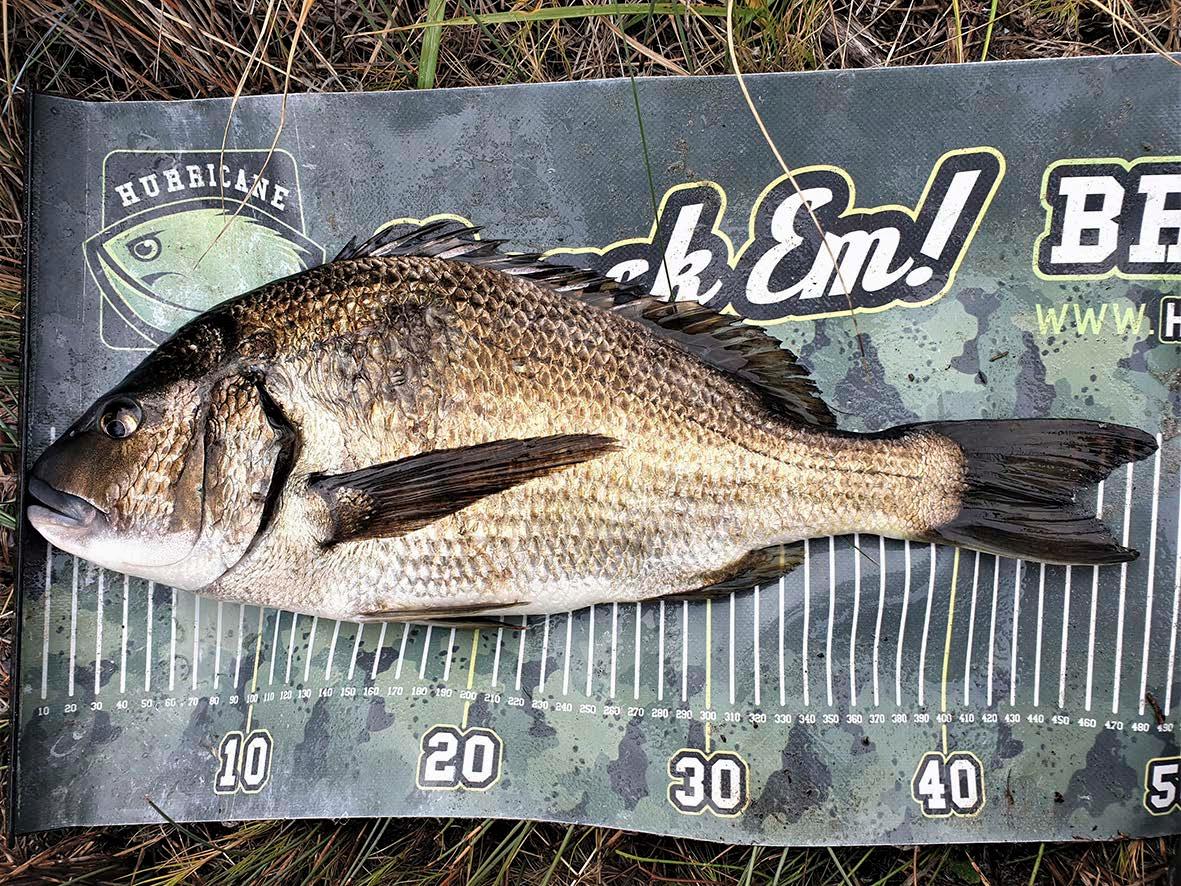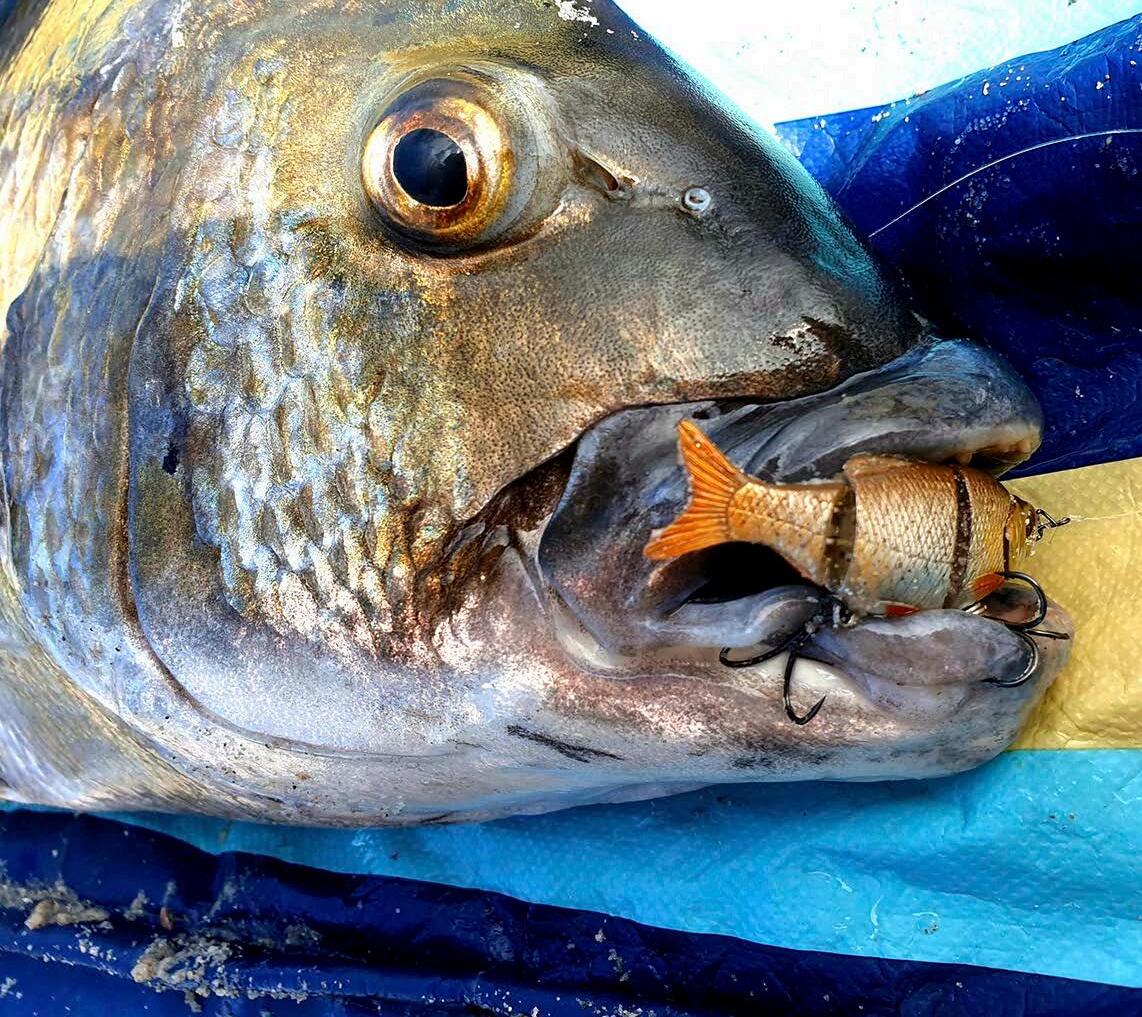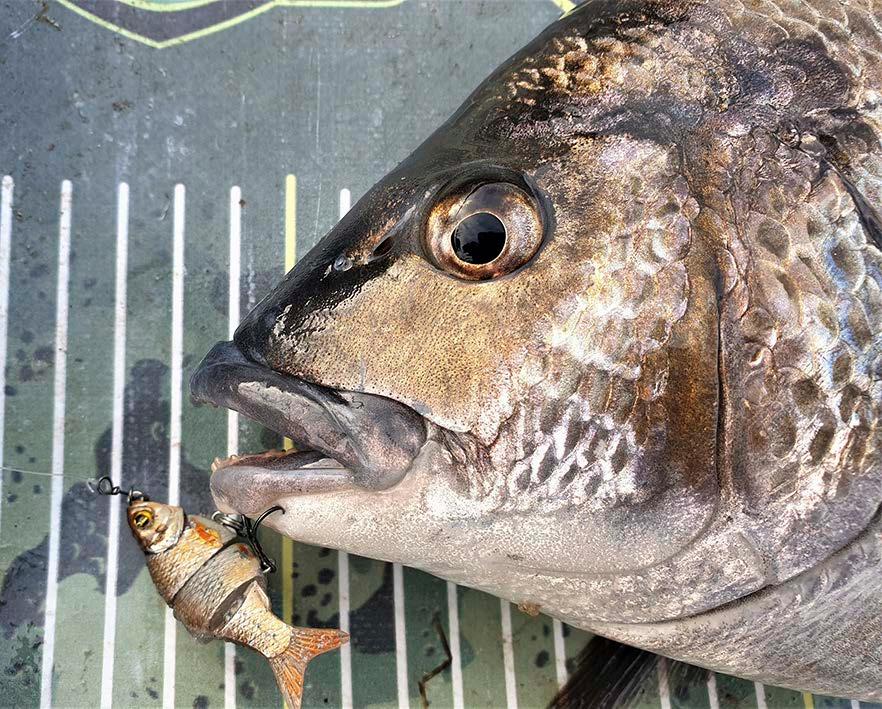
13 minute read
Discovering Swimbaits
Tasmanian fish are tasting something new
Scotto James
Every now and then something comes along on the fishing scene that changes the way you think about fishing. For me that has been jointed swimbaits. These are the most effective and versatile bream lures I have used - and by a significant margin. They are also incredibly effective on Trout. These iconic species are two of our most notoriously fickle lure targets and in general terms have not been associated with Swim Bait success in this country. These are fish that tend to bite at, rather than engulf lures. Now, throw into the equation more aggressive species like barramundi, smaller native perches, Murray cod, flathead, mulloway and a long list of pelagic, reef and estuarine species. Many of these fish feed in the same essential manner associated with the initial swimbait target species and thus a new lure phenomenon is set to rewrite lure lore and take Australia by storm.
The thunder already has begun!
Origins
Research indicates swimbaits likely evolved in the United States in the late 1980s via two separate sources near Los Angeles and in Texas respectively. The L.A. stream appears better documented. Allan Cole is attributed to be one of the first, if not the first swimbait designer and the creator of the A.C. plug. These lures were reportedly relatively basic rainbow trout patterns of around 22/23 cms in length, carved from wood and jointed in the middle with a rubber tail. Their targets were the large Striped Bass of Lake Pyramid near L.A. and the Large Mouth Bass of Lakes Castaic and Casitas. The lures were built to imitate the stocked trout of these waters. The lures reportedly accounted for impressive numbers of very large Bass and found fish for anglers struggling to come to terms with other lure patterns. In fishing terms, they were simply ‘the bomb’. These lures created a near instant following and as the swimbait craze began to develop, new players such as Mike Shaw entered the fray with the M.S Slammer in 1993. The following year, the Castaic Hard Bait, developed by Ken Huddleston and Chomp Joseph
What defines a lure as a swimbait?
A swimbait has its own physical attributes and forces that make it ‘swim’ with a very fish-like action. Where many lures only imitate a fish, a swimbait tries to replicate it; think of it as impressionism verses realism. A swimbait can be any size and work anywhere (floating, suspending and sinking) in the water column. A swimbait is almost always multi-segmented, being three or four (and sometimes more) pieces hinged together with metal or sometimes fabric, such as Kevlar. After all, it’s this design that is responsible for providing its unique full and tight S-shaped swimming action. It’s not ‘tripped’ by, or reliant on, a bib (lip or bill) for action … that’s a crankbait if it dives, or a wakebait if it’s super-buoyant with a high bib angle. Even if it’s jointed, if it has a bib, it’s not a swimbait.
From Hooked Up Magazine - Australia.
further improved design with more realistically visual patterns. These were said to be near exact replica’s ! Despite a price tag of 60 to 70 dollars in the mid Nineties, the lures were moving and apparently accounting for thousands of big fish.
The next advancement in design came from R.T Custom Lures who began pouring moulds with plastisol, thus moving away from traditional wooden manufacture. The lure incorporated a weighted hook harness and a ‘Lexan Wing’ was placed toward the back of the offering, initiating a realistic swimming action. Lead impregnation to the mould allowed these lures to be fished at the depths the angler required.
Lure development continued through Optimum Swim Baits who also incorporated lead into the moulding process of generic fish shapes allowing this lure to also be fished at a variety of depths. These lures were available for 8-12 dollars. Design advancement was now comparatively rapid and aimed at an ever increasing consumer base. Quickly moving forward to today, will reveal continued developments in swimbait technology with some of the original manufactures still major players within this field. Many designs attempt perfect replications and paint jobs are mint.
As to the argument of where the first swimbait was actually fabricated appears a bone of some contention, as the link to Texas and the first trials on fish at Lake Texoma appear real and may have in fact preceded the Californian strain of lures. Research would support that the early refinement of lures from humble beginnings to the masterpieces produced today, did however, take place in California. For us in Australia and neighbouring regions, their exact origins from the 1980s may seem a moot point, but trying to relay an accurate history of the lure style should be seen as important and necessary to pay homage to the individuals and companies involved .
Swimbaits In Australia
Small Swim Baits from brands like Izumi were available in Australia from retail outlets for a comparatively long time. (at the time of writing unavailability is unknown; supply will be addressed shortly) They caught some bream, bass, trout and an assortment of others but never really went mainstream. In many ways the second coming of swimbaits is poised to mimic the second coming of soft plastic lures and the history models are near identical. It was assumed Australian fish were a bit too intelligent to eat plastic, despite the lure style accounting for almost everything with fins within other world fishing circles. Enter, a couple of Australian fishing legends and a producer with some foresight and courage and the landscape of accepted lure fishing styles and techniques was changed overnight: well almost!
For my two bob’s worth, there is at least three major factors why swimbaits were not an initial and over whelming success on bream. The first probably has roots in our somewhat obsessive view of minnow style hard body lures and what many perceive as a shape and action necessary to catch them. Coupled with this are time frames to development literal techniques. It takes a while and it can be difficult to move away from patterns that work. Secondly, a lure without a bib needs an angler to bring it to life. It has no inherent directional orientation created by design, and this too mimics the luke warm acceptance and perceived limitations of early plastics, like Vibrotails and Mr Twister’s.

Thirdly, and perhaps for the most incredulous of reasons, swimbaits arguably swim more naturally and more realistically than any lure design ever made. As an aside to this, there is also zero feedback to the angler (on small swim baits) that the lure is ‘working’. There is no strong vibration emitted that we have become accustomed to with lure styles like bibbed minnows, blades, vibes, bibless fish imitations, metals and more. Comparisons to plastics are again inevitable. Swimbaits perform at their best when ‘fished’. Not simply retrieved!
Coming Terms With Perfection
The most obvious reason why swimbaits have not gained a strong following in this country is their action. Sounds weird right? If you haven’t swam a quality one, please do. They’re a near perfect visual imitation and swim as realistically as the fish they imitate under no duress. So folks have been casting and retrieving, marvelling at the action and finding modest or poor results. There are no bells and whistles, and most smaller offerings are without bearings. They’re a silent killer. But unless they pass fish during a peak feeding period, they’ll often return to one’s rod tip unmolested. Let’s try and create a visual analogy.
Many people have seen footage of sharks in the water that aren’t actively feeding. Cruising about through and around schools of fish. Interestingly, the fish appear not threatened by the shark. Nothing can feed 24/7. There are long periods of any day when both prey and predator co-exist in a complete harmony of nature. Slow rolling a swimbait is not imitating a distressed animal. They swim as a healthy fish is supposed to. Now throw a writhing, struggling, dying fish into that same equation. The shark is going to eat it and we pretty much all know it will. If the sharks stomach capacity is at its limit it will still attack the dying fish, even if it forces the shark to regurgitate what it’s just eaten.
The shark is simply programmed to react to specific stimuli. This action may well be closer to reflex than instinct. The ‘death flutter’ is what swimbaits replicate better than any other lure. Imagine once again in your mind what a dying ,writhing bait fish looks like. With imagination and a little practice these delicately multi jointed presentations will behave in exactly this fashion. In fact, they’ll behave in just about any way you ask them to. What may be seen as another hint regarding how to present these lures effectively is on the back of some swimbait packaging. The directions ask us to fish them this way. Not slow and simply wind them in.
Yet another benefit of these lures, and likely the most important is the ability to actively fish them on the drop. A very natural sink rate, not a lure plummeting to the bottom. No other hard body fish pattern can die this realistically on the way down. Science tells us approximately 70% of dying fish sink. Only 30% float. So the ability to work this lure on the drop puts it in a class of its own and imitates what predatory fish are programmed to react too. Before swimbaits found their way into my tackle box, ‘shut downs’ due to a variety of factors were common enough and finding fish on tough days was indeed tough. Diligent experimentation fishing for several hours and throwing every ‘go to’ successful pattern at bream and drawing blanks have regularly been turned into fantastic sessions by the ‘Shad Alive’ in 50mm. Not just a fish or two. Really dynamic sessions!
There are also no real depth design limitations with swimbaits and the entire water column is at your disposal. The same brand in the 80mm also produces great results in the right circumstances and they catch large fish. Of course ‘shut downs’ will and do occur. They always will. My definition of one has changed somewhat through the use of these little gems. ‘Shut Downs’, for the most part are simply fish not responding to the more mainstream lure types we’ve been throwing to them. Many ‘shut downs’ are fish shut down to the presentations available to us. Not necessarily fish with complete lock jaw. Passively feeding fish and filter feeders in ultra passive modes can be undone with these lures and effective presentations. It doesn’t really matter whether its an instinctual reaction to a perceived death, an uncontrollable type of reflex action or any of a million other reasons. The simple truth is bream will often bite at or try to eat 50 to 80mm swimbaits whether they’re actively feeding or not. At this point in juncture another branded swimbait apart from the Izumi has not been trialled. It hasn’t been necessary. These things have been flogging big bream with such regularity that the simple joy of catching fish, learning and experimenting with techniques and trying to absorb and understand the opportunities provided by this lure style has taken all available time. As mentioned, there are many other brands. Trialling with those has not yet began.
In the beginning
All journeys have a start point. Picking up a lure in a junk box for 6 dollars in Queensland in 2012, with the goal of trying to temp a trout on an untried pattern, is a very long way away from its emergence as an extremely versatile black bream lure. A million to one shot. Obtaining a property in Tasmania’s East Coast Highlands was a dream 20 years in the making and finding a property at Lake Leake, a terrific mixed brown and rainbow trout fishery, turned that dream into reality. The lake also has a robust redfin (english perch) population. At this point in time, footy commitments were being honoured on Queensland’s Sunshine Coast over winter. A great catch up with lifelong mates and some respite from a harsh winter climate up in the hills of Tasmania. Pulling on the boots whilst ‘trying’ to coach the Pomona Demons Masters side and attempting to get this broken body up for first grade, when required, are challenges that shape lives, minds and bodies alike! Contact sport after 50 isn’t easy.

It was indeed a long list of co-incidences and good fortune that saw me again with old friends at Davo’s Bait and Tackle in Noosa when a nonchalant rummage through a ‘specials bin’ whilst chatting all things Tasmania, revealed a perfect, multi jointed redfin imitation. With knowledge of Leake’s perch population the lure was very quickly added to the bag of goodies already at hand. So it came to pass the lure was clipped on one bleak afternoon at Lake Leake, casting to the ridiculous amount of structure on the lakes aptly named ‘Big Woody Shore’. They’re a good choice over structure as the lure’s depth is easily governed. Again good fortune came into play as it was an afternoon brown trout were on the chew. In fact, and despite a life obsessed with browns and travelling this country to find them, it was the most remarkable response to any single lure experienced.
A quick call the next morning to Davo’s back at Noosa and a box of 10 was ordered. The price was a bit of a shock after the initial purchase, however regardless of this, these perfect little redfin patterns were finding their way back to Tasmania. Over the next 12 months the lures produced a stack of browns but as often happens with fishing, other techniques were evolving on my home water and without conscious thought, these diminutive little swimbaits slowly entered the back of my mind and the bottom of tackle boxes. Moving along to mid 2017, and a young mate, Jarvis Wall and I were chatting regarding him chasing some really big redfin. He was trying to go beyond 50cm and was already very close to that mark with some huge hulking fish. The young man is something of a prodigy and the water he was fishing contained copious weed. Good presentations were not easy. Because swimbaits offer the angler total control of depth, and vertical descent, they were discussed and some photos of the lure’s were sent to him.
But instead of that lure going back to the box it came out of, it went into my small ‘go-to’ box that resides in the front pocket of my waders. More coincidence at play. There was no reason to do this. It simply happened. Anyone who’s tried to take a pack sack off in waste deep water will understand the associated problems and probably have a little box secreted in their wader pocket or carry a waist bag of some description. The next bream mission was to an East coast micro system. Throwing lightly weighted grubs, which normally work well there was drawing blanks. Fish were following the plastic to the rod tip and despite every form of manipulation possible, success could not be found. There were small schools of half a dozen good fish milling around the lure. There were no erect pectoral fin’s or other sings of agitation. It was casual interest at best. If they wanted to feed it was time to try other things.
From there, several of the most successful hard bodies on that water were tried without success as the session progressed upstream. Weed totally prohibited more general bottom fishing. It was almost home time and a single strike had not been registered.


On the return trip back and approaching the area where the plastics drew attention earlier, another was presented for the same result. Two or three casts later and after again witnessing fish under the rod tip, the follows ceased. Whilst taking the plastic off and placing it into the small box from my waders the redfin pattern was observed. After such success on trout all those years ago the immediate issue of sink rate came to mind. So did the fact it was a freshwater English perch pattern. Was it worth a crack? Or just continue home?
The 50 mm ‘Shad Alive’ was quickly clipped on and a fish secured second cast. The next two hours were chaos with over twenty bream making it to the net before counting become an ordeal. The fish were left biting. That afternoon a lot was learnt about how sink rates can effect apparently shut down bream. As was the difference between horizontal retrieves and vertical ones. But the most important factors were most definitely sink rate and action. No other hard bodied lure can attract that response. In many ways it was the afternoon that should not have happened. A crazy divergence of observation, luck, years of impossible coincidence and opportunity. Bream fishing just got changed forever!
Summary
After that initial session, which proved no more than the lure had huge potential, it was time to refine techniques and just play with these lures and enjoy the benefits of catching fish that were not willing to accept other lures presented in time honoured ways. And time honoured techniques are already very effective. Aware, that at least where trout are concerned, some techniques are most definitely location specific, many months were spent travelling and fishing large rivers, tiny creeks, land locked lagoons and everything in between. The tiny swimbaits continue to deliver but its their ability to find really tough fish that continues to delight. Maintaining the thought that these lures were primarily designed to catch fish that create a vacuum when feeding, by opening their mouths and engulfing prey, the realistic proposition of them being used on Australian species that feed exactly that way should lead to swimbaits being a huge lure trend in the 2020s. The potential really is that big. The U.S models drew an initial cult following which very quickly went mainstream.
The success of these lures isn’t about design features for specific species. It’s a design feature developed primarily to accommodate a feeding behaviour. With this knowledge, all species world wide that feed this way are prime targets. A yardstick where brilliance and simplicity meet. The basic fact that predatory fish with small mouths and diverse diets are also engaged by these lures is an accurate testimony to the unique actions available to the angler. Their success on Murray cod and barramundi is already being acknowledged (larger Swim Baits) and it is imagined this success will continue to grow as anglers play with technique. Their effectiveness on flathead has already been explored and lizards love them. No surprises there. Having them pull luderic , mullet, leather jacket’s and flounder was surprising to begin with, but everything in the estuary appears keen to have a crack at them. Unfortunately tailor take them with relish too. Not a great thing on light leaders. Pelagic’s are taking far bigger purpose built models that can be trolled at speed and here a lifelike presentation is more readily accepted. To put it simply, If your target species eats fish, they’re going to eat a well presented, well designed and appropriately sized swimbait!
Supply

At the time of writing Izumi Swimbaits seem unavailable in shops, though this will hopefully change promptly via demand. Don’t feel disparaged by some lures carrying European freshwater bait fish profiles/ colours. They work! The redfin pattern, for example, should be viewed like any other black/green shaded lure with a dash of red on it. Golds/yellows the same. The silvers/blues the same. The red head, white body










